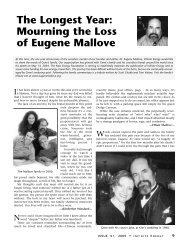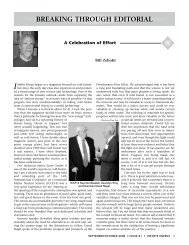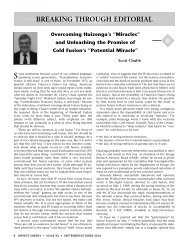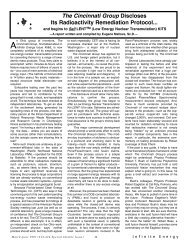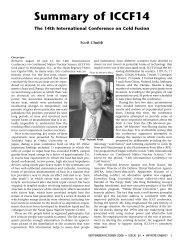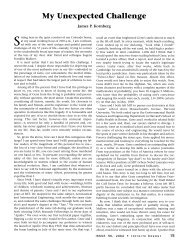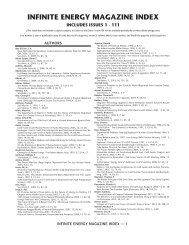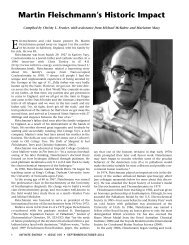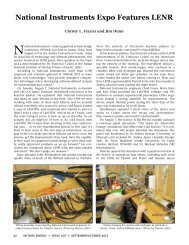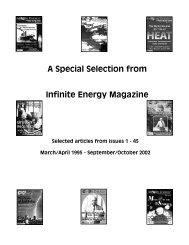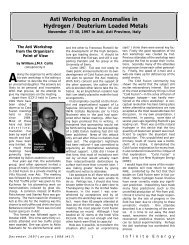MIT and Cold Fusion: A Special Report - Infinite Energy Magazine
MIT and Cold Fusion: A Special Report - Infinite Energy Magazine
MIT and Cold Fusion: A Special Report - Infinite Energy Magazine
You also want an ePaper? Increase the reach of your titles
YUMPU automatically turns print PDFs into web optimized ePapers that Google loves.
Exhibit C<br />
<strong>MIT</strong> News Office Deceptive Press Release<br />
I had been up into the wee hours of the night of April 30-May 1,<br />
1989, sending a press release dictated to me over the telephone<br />
at my home in Bow, New Hampshire by Professor Parker.<br />
I telephoned it to UPI, Reuters, <strong>and</strong> the Associated Press,<br />
<strong>and</strong> it denied what Parker had said in the interview with the<br />
Boston Herald’s Nick Tate. When I arrived at the <strong>MIT</strong> News<br />
Office early that morning after a sleepless night, we hastily put<br />
together a printed form of the press release to h<strong>and</strong>le the<br />
approaching storm. This is the text of the Press Release that<br />
was issued from the <strong>MIT</strong> News Office on May 1, 1989. On the<br />
day of my resignation from my <strong>MIT</strong> News Office position, June<br />
7, 1991, I publically disavowed this Press Release—an unintended<br />
falsification of the truth in which I was used as a dupe in<br />
part of an orchestrated campaign against cold fusion (an image<br />
of this Press Release appears on page 76)—EFM<br />
<strong>MIT</strong> News Office PRESS RELEASE May 1, 1989<br />
URGENT MEDIA ADVISORY<br />
For Immediate Release May 1, 1989<br />
<strong>MIT</strong> Contact: Eugene F. Mallove, Sc.D. Chief Science Writer<br />
CAMBRIDGE, Mass., May 1—Professor Ronald R. Parker,<br />
Director of the <strong>MIT</strong> Plasma <strong>Fusion</strong> Center responded today to<br />
an article published this morning in the Boston Herald, an article<br />
that he says has seriously misquoted him <strong>and</strong> given a largely<br />
incorrect view of his discussions with the Boston Herald’s<br />
reporter, Nick Tate.<br />
Professor Parker issued this statement:<br />
“The article erroneously characterizes remarks that I<br />
made regarding the cold fusion experiments done at the<br />
University of Utah. Specifically, I did not: (1) Deride the<br />
University of Utah experiments as “scientific schlock” or (2)<br />
Accuse Drs. Fleischmann <strong>and</strong> Pons of ‘misrepresentation<br />
<strong>and</strong> maybe fraud’.”<br />
Today, Professor Parker’s colleagues will present a paper<br />
(co-authored with him) at the meeting of the American<br />
Physical Society in Baltimore, Maryl<strong>and</strong>, in which they suggest<br />
that data that Drs. Pons <strong>and</strong> Fleischmann claim support<br />
the observation of neutron emission in their experiments<br />
were misinterpreted by Pons <strong>and</strong> Fleischmann.<br />
Based on their independent analysis, the <strong>MIT</strong> researchers<br />
say that if neutron emission occurred in the Pons <strong>and</strong> Fleischmann<br />
experiment that they reported in the Journal of Electroanalytical<br />
Chemistry, it would have been at a level far<br />
below that reported by the University of Utah group.<br />
Exhibit D — Boston Globe Letter to<br />
<strong>MIT</strong> President Paul Gray —April 17, 1989<br />
There is convincing evidence (see Exhibit B) that Prof. Parker<br />
had made a deliberate attempt to exclude the “cheer-leading”<br />
Boston Globe from getting access to the <strong>MIT</strong> PFC in the hectic<br />
early days of the cold fusion uproar. Frustrated Globe science<br />
writer Richard Saltus wrote an extraordinary letter on April 17,<br />
1989 to then <strong>MIT</strong> President Paul E. Gray. This was before the<br />
Herald’s bombshell story of May 1, 1989 broke!—EFM<br />
The Boston Globe, Boston Massachusetts 02107<br />
Telephone 617-929-2000<br />
Paul E. Gray, President, Massachusetts Institute of Technology<br />
Dear Dr. Gray:<br />
We in the Sci-Tech section have always regarded <strong>MIT</strong> as a rich <strong>and</strong><br />
crucial source of ideas <strong>and</strong> information. The News Office does an<br />
invaluable job in bringing stories to our attention, <strong>and</strong> the faculty <strong>and</strong><br />
staff generally are very helpful when we call on their expertise. In addition,<br />
your visit to the Globe left a strong impression, <strong>and</strong> created<br />
renewed interest in subjects like science <strong>and</strong> math education <strong>and</strong> global<br />
environmental issues.<br />
It has been disturbing, therefore, to have encountered such a lack of<br />
cooperation—a selective one, it appears—from the leadership of the<br />
Plasma <strong>Fusion</strong> program during our reporting of the claimed breakthrough<br />
at the University of Utah. We felt our readers would want to<br />
know how this scientific controversy has affected a premier fusion<br />
research center—<strong>and</strong> one in the Globe’s city.<br />
However, repeated attempts by myself <strong>and</strong> another reporter to talk to<br />
individuals at the Plasma <strong>Fusion</strong> Center have met with little success. In<br />
the first weeks of the story, Dr. Ronald Parker did make himself available<br />
on a few occasions, but for the past week or more has failed to<br />
return phone calls.<br />
I also was utterly rebuffed in an attempt, which I had cleared with the<br />
News Office, to visit the fusion center briefly— entirely at Dr. Parker’s<br />
convenience—so that I could convey something of the activity there<br />
during this highly unusual time. I called several times, dropped by<br />
once, <strong>and</strong> left telephone numbers where I could be reached, saying I’d<br />
be glad to talk with anyone who had a free moment. The secretary<br />
promised to let me know what could be arranged. However, no one<br />
ever responded. I appreciate the enormous dem<strong>and</strong>s on Dr. Parker’s<br />
time. Yet, he has found time for other publications, including the Washington<br />
Post —whose reporter toured the facility, took photographs <strong>and</strong><br />
interviewed several researchers <strong>and</strong> the New York Times, which quoted<br />
Dr. Parker as recently as last Sunday.<br />
Whether this selective access reflects caprice or some bias against the<br />
Globe is hard to tell. In any case, it is regrettable that we have had to<br />
give up on <strong>MIT</strong> <strong>and</strong> turn to institutions like Princeton, where, although<br />
I am sure they are no less busy, researchers have been more helpful.<br />
Sincerely,<br />
Richard Saltus, Science writer<br />
cc: Dr. Ronald Parker, Plasma <strong>Fusion</strong> Center<br />
Exhibit E — <strong>MIT</strong> President Paul Gray’s Letter to the<br />
Boston Globe May 1, 1989<br />
<strong>MIT</strong> President Gray, apparently unaware of Parker’s true dealings,<br />
was himself duped into writing what he honestly thought<br />
was a valid response to the Globe’s Saltus.—EFM<br />
Richard Saltus, Science Writer<br />
The Boston Globe<br />
OFFICE OF THE PRESIDENT<br />
Dear Mr. Saltus:<br />
I write in response to your letter of April 17, which laments<br />
the recent inaccessibility of Professor Ronald Parker. I have<br />
looked into this <strong>and</strong> find that Professor Parker has been deluged<br />
by requests for information about cold fusion <strong>and</strong> is unable to<br />
respond to all of them. He has tried to be as helpful as possible,<br />
consistent with his belief that judgment should be reserved<br />
until the scientific facts are clarified. That cautious stance has<br />
led him to discourage all media visits to the Plasma <strong>Fusion</strong> Center,<br />
although his efforts have not always been successful.<br />
I have been assured that there was no discrimination<br />
against the Boston Globe <strong>and</strong> that, to the contrary, Professor<br />
Parker spoke five or six times with your colleague, Mr. David<br />
Ch<strong>and</strong>ler.<br />
I regret that you feel ill used during these recent events, but<br />
I am satisfied that they are merely a consequence of the extraordinary<br />
circumstances attendant to the claim of cold fusion.<br />
We certainly hope that our good relations with the Boston Globe,<br />
<strong>and</strong> with the Sci-Tech section in particular will continue.<br />
Sincerely yours,<br />
Paul E. Gray<br />
PEG/mmd Signed in his absence<br />
cc: Kenneth D. Campbell, Ronald R. Parker<br />
27 <strong>Infinite</strong> <strong>Energy</strong> • ISSUE 24, 1999 • <strong>MIT</strong> <strong>Special</strong> <strong>Report</strong>



